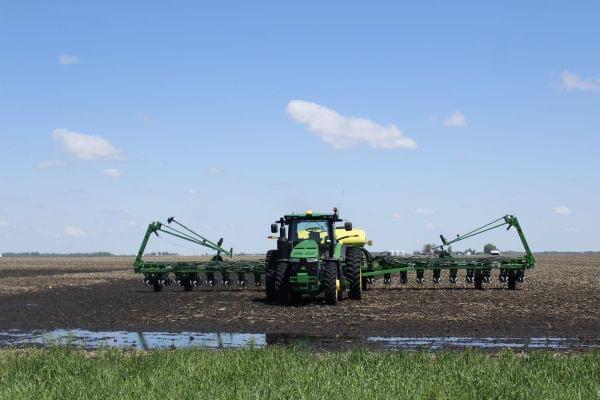Who Is (And Isn’t) Representing America’s Farmers In Congress

A tractor idled in a field that was too wet to farm in central Illinois this spring. Madelyn Beck/Harvest Public Media
The USDA’s 2017 Ag Census recently revealed which congressional districts represent the most farm producers.
It’s little surprise that the Midwest and Plains states dominate the top 20 slots. But the vast majority of U.S. House members have few farmers to answer to, compared to the rest of the people they represent.
South Dakota ranks third on the list for the number of farm producers (48,913), and has just one representative, Republican Dusty Johnson. He said he has to work closely with other rural representatives to make sure farmers voices are heard.
“There are only a few dozen members of the U.S. House who represent districts that are more rural than urban, and mine is one of them,” he said. “No question, the people I work with most closely are the folks from states like Montana or North Dakota or other strong ag states like Minnesota, Iowa, Nebraska.”
Speaking of Nebraska, its 3rd District represents the most farmers of any U.S. district at 55,834 farm producers. It also represents the most farms, 33,294.
For GOP Rep. Adrian Smith, who speaks for the western two-thirds of the state, it’s a point of pride.
“Even in the midst of challenges that we are facing in the ag economy, when you look at the innovation and the creativity and the hard work, it really shows what’s great about America,” he said.
Those challenges range from flooding to trade wars. Some like John Hansen, president of the Nebraska Farmers Union, are calling on members of Congress to do more, regardless of how many farmers they have in their district.
“Through the ’80s, there was an enormous amount of financial damage done,” he said, noting the loud calls for help that came along with it. “So this time, it’s just been a very quiet farmer-by-farmer exit going out the door. There’s not been a loud outcry.”
Here are key report highlights:
- Iowa’s 4th District is No. 2 on the list with 54,187 farmers and 33,007 farms. It’s represented by embattled GOP Rep. Steve King.
- The rest of the Top 10 farm-producer congressional districts are in Minnesota, Oklahoma, Montana, Kansas, Missouri and North Dakota.
- The Congressional District with the most farmers in Illinois is the 15th, with 33,404. That ranks No. 16 on the list. The district is represented by Republican John Shimkus.
- The top 10% of farmer-heavy districts represented 40% of all farm producers.
- Congressional districts with the fewest farm producers were in urban centers in New Jersey, California, parts of New York state and Illinois (Chicago and its suburbs).
- The bottom 10 districts represented a total of 68 farm producers and 45 farms.
- There are 421 congressional districts. When listed from most producers to least, the bottom half only represent 6% of all listed U.S. farm producers.
Some caveats: The report, while released this year, uses 2017 data; depended on voluntary census submissions; and only counts up to four producers on the same farm. That excludes extra producers on sprawling operations in the Midwest and additional producers on compact urban garden operations.
Follow Madelyn on Twitter: @madelynbeck8
Links
- Meating In The Middle: The Challenge of Lowering Greenhouse Gas Emissions On Farms
- Critics Say USDA Plan To Move Federal Agencies Could Hurt Research Vital For Farmers
- Illinois Farmers Delay Planting Crops Amid Wet Weather, Low Crop Prices, And Trade Uncertainty
- Farm Equipment Sales Drop In Early 2019 As Trade War’s Effects Linger

